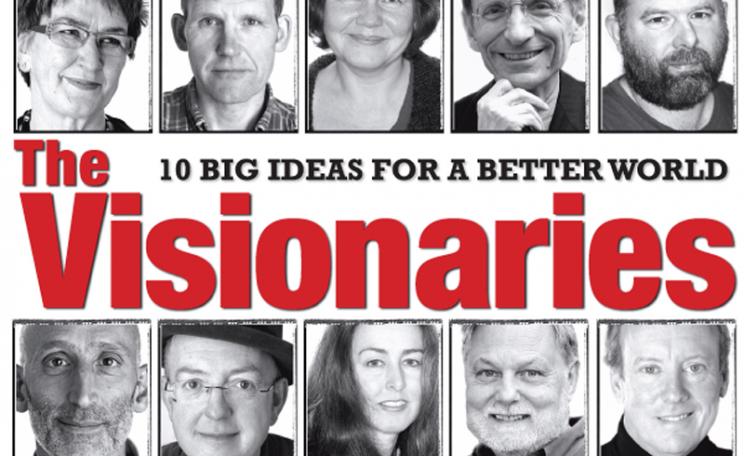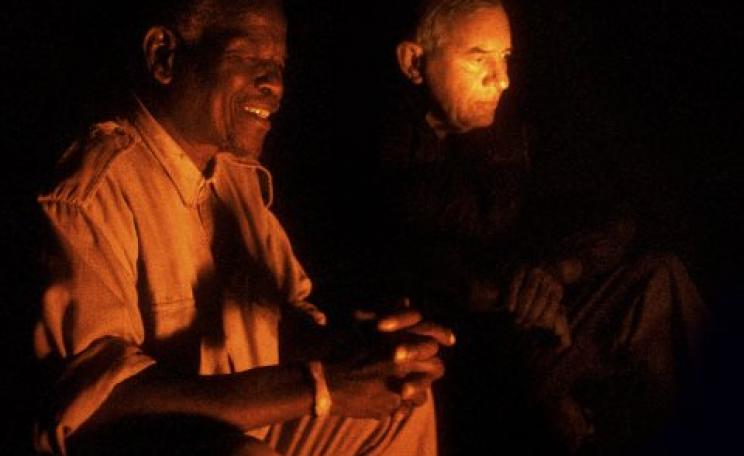Mona Polacca was 14 years old when she first heard the Hopi prophesy, but she remembers it as though it were yesterday.
‘An elder came to our village and told us there were big changes coming,’ she recalls, ‘He told us that the things we relied on were being consumed at such a rate that we may be left with nothing. He taught us to know where our resources are: to know where our sacred water is; to know how to build our sacred fire; to know our herbs and medicines. It was all about survival on the most basic level.’
Mona remembers it so well because, as he was leaving, the elder predicted a big storm would hit her village by sundown.
‘And that’s what happened,’ she says. ‘It was an affirmation of his message that shook me to the core. It made me believe that what he was saying was real, not just talk.’
That, almost 50 years ago, was where Mona’s journey began. Blessed with the gift of nearperfect oral memory, her elders spent hours teaching her the old ways and prophecies word for word, trusting their information would be safe in her hands. ‘And that is pretty much the work I am doing today,’ she says.
Mona is one of the International Council of Thirteen Indigenous Grandmothers, currently travelling the world to hold council, pray for peace and bring pressure on world leaders to take seriously the degradation of the Earth.
In October 2004, they came together from the Arctic Circle, North, South and Central America, Africa and Asia, all at the invitation of Jeneane Prevatt, known as Jyoti, a Cherokee spiritual counsellor who sent out over 100 invitations to elders around the world to honour the ancient matriarchal authority that once had the final say in all tribal matters, including decisions on war.
Thirteen grandmothers showed up in Phoenicia, New York, in lands once belonging to the Iroquois Confederacy. It was a powerful, magical call to service on behalf of the world.
‘We all brought our prayer bundles, our water, earth and ash from our fires. Then the grandmother from Alaska opened her bundle and in there were 13 stones. She gave each of us one, telling us that when she turned 12 her great-grandmother had given her the stones and told her, “One day there will come a time when you’ll be sitting at a table with 12 other grandmothers. Give these stones to them”.’
All the grandmothers shared prophecies about their coming together. ‘Indigenous people have come through a time of great struggle, a time of darkness,’ Mona says. ‘We grandmothers, we have emerged from that darkness, see this beauty, see each other and reach out to the world with open arms, with love, hope, compassion, faith and charity.’
Since then the grandmothers have held five councils: In New York state and New Mexico, in the US, in Mexico itself, in Dharamsala, India, at the request of the Dalai Lama, and in the Black Hills of Lakota. In April they go to Australia; in July they will visit Gabon, Spain and France. Everywhere they hold ceremonies for the Earth and lead local people in prayer. Their agenda is broad: from universal evocations to lobbying on behalf of local issues concerning water, land and human rights.
Mona answered Jyoti’s call because she has been fighting for indigenous rights all her life. Her training in tribal ways actually began long before her epiphany at 14. From the moment she was born into the Colorado River Indian tribes she has learnt the ways of her people. Part Hopi on her father’s side, and Havasupi and Tewa on her mother’s, she learnt about the forced relocations and great migrations of her people, which led to a congressional act that consolidated four tribes on the Colorado River.
Though removed from their lands, her elders still taught the children the ‘Indian way’.
‘“These are your relatives in the Indian way,” they would tell us. “These are your brothers, your mothers. Be kind to one another. Share what you have with your brothers and sisters.” And if someone had the good fortune to have more than they needed they shared it with the rest of the family and the community.’
From the earliest time Mona’s mother would tell her, ‘You are not in this world just for you. You are representing first your family, then your tribe, then your people. What you do and what you say will reflect on all of us.’
Since then Mona has been in service to her community, working with public health and drug and alcohol addiction. Currently she is studying for a PhD in Justice Studies at the Arizona State University. That is still her ‘day job’, although her work with the Council of Grandmothers takes her around the world.
Although the grandmothers work on a political level, their most important role, according to Mona, is prayer. ‘When we travel to places we go and plant our prayers. Our water, our earth, the ashes from our fires, our medicines are offered as prayer. We are invited to come and pray, and all we stand behind is the prayers. Prayer is our survival.’
I tell her that to most Western minds, prayer seems a flimsy hope on which to pin the survival of the world and ask her to explain how it works. She describes two incidents where she believes prayer helped stave off destructive developments.
‘On the Fort McDowell Indian Reservation called the Verde River, there was a threat to build a dam so they could create waterfront property on this great lake. Only it meant they would flood out this tiny tribe who had no significance for the developers. The tribe called out for help, so indigenous medicine people came from the west and east, held ceremonies, prayed and put medicines there to protect the land, and they defeated the dam.’ The tribe has since become very prosperous.
Another time, the elders gave permission for a corporation to mine gypsum on a sacred mountain close to Mona’s own reservation, the one towards which she looked when she did her morning prayers. The elders believed the mine would bring much-needed jobs, but Mona knew they would be transitory.
‘So I began to pray to the spirits of the mountain, asking that they take care of themselves,’ she recalls. ‘You know, they could never get equipment up that mountain. The trucks broke down and once they got the equipment up there, it broke down too. The company started losing money and pretty soon begged to be let out of their contract.’
The Indian way, or Red Road as it is known, revolves around prayer: prayers to the four directions; to the Sun; to the elements; to the ancestors. As a child, Mona recalls prayers first thing in the morning, at meal times, before leaving house, before any projects were undertaken; always asking that the spirits of life support and protect them.
When she prays to the mountain or the elements is she ‘empowering’ them? Mona laughs. ‘We are not that powerful,’ she says. ‘We are simply acknowledging their power and calling on that power to be present.’
She cites the research of Masaru Emoto, the Japanese scientist who measured the effects of human thought and vibrational presence on water showing the seemingly miraculous patterns made by water’s molecular structure. ‘We pray with the elements,’ she says, ‘and he has proven that how you talk to water creates how the water is going to be.’
According to Hopi prophecy, immortalised on an ancient rock near Second Mesa on Hopi land, there are two roads that mankind is currently on: one is a life out of balance or koyaaniskatsi, a life in turmoil predicated on technology, materialism and greed. That road will terminate. But another road, the spiritual road, which is reached by a bridge of changing consciousness, stretches long into the future, predicated on a return to the rhythms of life in balance, in tune with the environment around us. The question is whether we will choose to cross that bridge, to take that road.
Mona is sure the great earth changes, called the Great Purification in Hopi prophecy, have already begun. She recalls her mother telling her that in one day thousands of people were going to disappear. ‘I used to wonder about that. I thought it might be connected to the Christian prophecy of believers being taken up to heaven; then I thought maybe she was talking about alien abductions. Then I heard about the tsunami and they were saying “thousands of people had been wiped off the face of the earth” and I knew instantly this was what my mother had been referring to.’
Is Mona ultimately optimistic about our future survival? She recalls a pipe ceremony 28 years ago.
‘This is what the elder said, “Things are beginning to change and we are praying, doing this ceremony, crying for the ones who we are going to have to step over. Not everyone is going to embrace these teachings and walk a life in balance. They are going to fall. They are not going to be able to make it. And some of them will be people we love. But there will be those who will be able to carry on.” That is what we were told and I still hear it today. There is a sadness that not everyone is going to be “saved”, for want of a better word, but there has always been the certainty that some of us will survive.
‘Ever since then we have been preparing ourselves. But sometimes I still ask myself, if I had to run for my life, could I? Now that is a very basic question.’
Nicola Graydon is a freelance journalist
This article first appeared in the Ecologist April 2008







